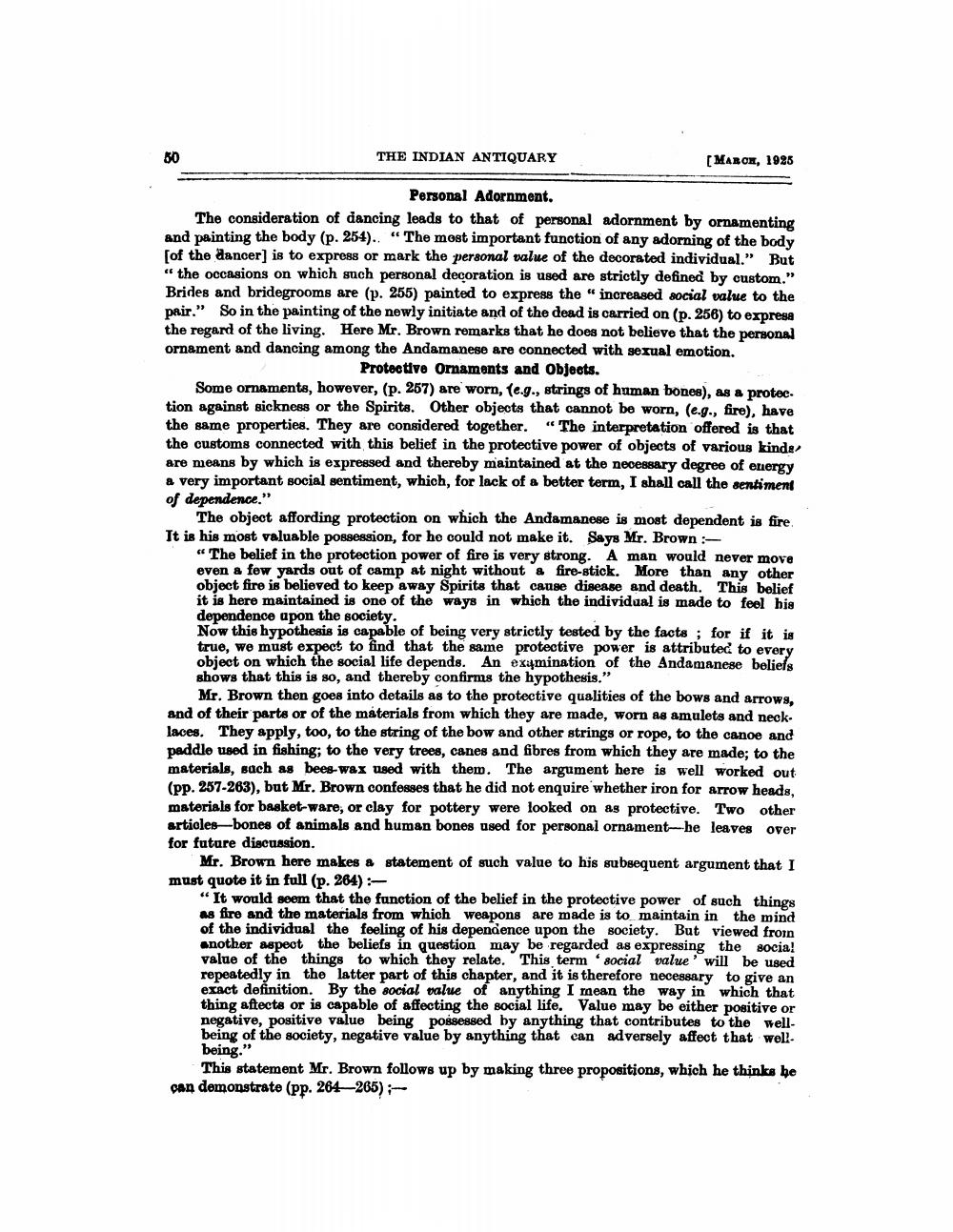________________
80
THE INDIAN ANTIQUARY
[MARCH, 1925
Personal Adornment. The consideration of dancing leads to that of personal adornment by ornamenting and painting the body (p. 254). "The most important function of any adorning of the body [of the dancer) is to express or mark the personal value of the decorated individual." But " the occasions on which such personal decoration is used are strictly defined by custom." Brides and bridegrooms are (p. 255) painted to express the "increased social value to the pair." So in the painting of the newly initiate and of the dead is carried on (p. 256) to expresa the regard of the living. Here Mr. Brown remarks that he does not believe that the personal ornament and dancing among the Andamanese are connected with sexual emotion.
Protoctivo Omaments and objects. Some ornaments, however, (p. 257) are worn, (e.g., strings of human bones), as a protec. tion against sickness or the Spirits. Other objects that cannot be worn, (e.g., fire), have the same properties. They are considered together. “The interpretation offered is that the customs connected with this belief in the protective power of objects of various kinds are means by which is expressed and thereby maintained at the necessary degree of energy a very important social sentiment, which, for lack of a better term, I shall call the sentiment of dependence."
The object affording protection on which the Andamanese is most dependent is fire. It is his most valuable possession, for he could not make it. Says Mr. Brown
«The belief in the protection power of fire is very strong. A man would never move even a few yards out of camp at night without & fire-stick. More than any other object fire is believed to keep away Spirits that cause disease and death. This belief it is here maintained is one of the ways in which the individual is made to feel his dependence upon the society. Now this hypothesis is capable of being very strictly tested by the facts ; for if it is true, we must expect to find that the same protective power is attributed to every object on which the social life depends. An examination of the Andamanese beliefs shows that this is so, and thereby confirms the hypothesis."
Mr. Brown then goes into details as to the protective qualities of the bows and arrows, and of their parts or of the materials from which they are made, worn as amulets and necklaces. They apply, too, to the string of the bow and other strings or rope, to the canoe and paddle used in fishing; to the very trees, canes and fibres from which they are made; to the materials, sach as bees-wax used with them. The argument here is well worked out (pp. 257-263), but Mr. Brown confesses that he did not enquire whether iron for arrow heads, materials for basket-ware, or clay for pottery were looked on as protective. Two other articles bones of animals and human bones used for personal ornament-he leaves over for future discussion.
Mr. Brown here makes & statement of such value to his subsequent argument that I must quote it in full (p. 264)
“ It would seem that the function of the belief in the protective power of such things as fire and the materials from which weapons are made is to maintain in the mind of the individual the feeling of his dependence upon the society. But viewed froin another aspect the beliefs in question may be regarded as expressing the socia! value of the things to which they relate. This term 'social value' will be used repeatedly in the latter part of this chapter, and it is therefore necessary to give an exact definition. By the social value of anything I mean the way in which that thing aftects or is capable of affecting the social life. Value may be either positive or negative, positive value being possessed by anything that contributes to the wellbeing of the society, negative value by anything that can adversely affect that wellbeing."
This statement Mr. Brown follows up by making three propositions, which he thinks he can demonstrate (pp. 264–265);




